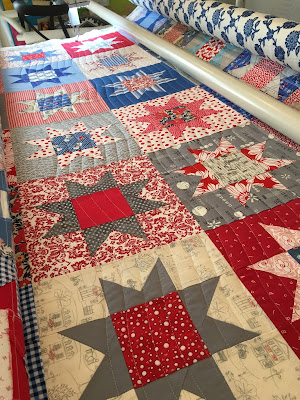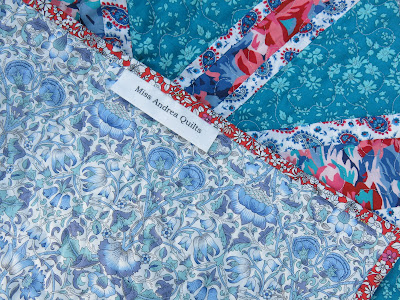It's been so enjoyable to reflect on this quilting venture from my past....
Here's the backstory:
Twenty-two years ago, my Aunt Joan invited me, my mother, my two sisters, and her two daughters to join her in making a scrappy nine-patch star quilt.
The pattern was featured in the May and June 1995 issues of Quilters Newsletter Magazine. (The magazine is no longer in print - talk about feeling old!)
It was a great concept - each participant was to cut out and stitch enough blocks for their own quilt, then swap them with the group, resulting in a super scrappy quilt top.
So, at our annual family reunion in 1995, Aunt Joan got us organized, gave us instructions, and sent us home to get to work.
The following summer, we swapped blocks at my grandmother's kitchen table.
Each of us also made signature blocks to swap.
Using a light box, we traced patterns and signed our names.
 |
| My mother Ila Learn Hoke |
Then, we headed home again to assemble our quilt tops.
A year later in 1997, we showed off our completed quilt tops to each other.
Finally in 1998 at my grandparents' 70th wedding anniversary, we displayed all seven quilts on the clothesline at their farm in Indiana County, PA.
 |
| Left to right: my sister Alison, me, my sister Renee, and my mother |
 |
| My Aunt Joan (my mother's sister) and my mother |
 |
| Quilters Newsletter Magazine, 2001 |
A few years later, my aunt submitted our picture to Quilters Newsletter Magazine, and our "Cousins Quilts" were featured in the Letters to the Editor section - how fun!
But the story gets better!
Imagine my surprise when I read Sherri McConnell's recent blog post on A Quilting Life - she posted pictures of a quilt top of her grandmother's that she had just discovered, and that she was planning to host a quilt along, inviting her readers to stitch the very same quilt along with her. I was sure it had to be our quilt! I pulled out my quilt and studied it - indeed, it certainly appeared to be identical! How fun that her grandmother had stitched the same quilt as we did, and quite likely during the same time period.
It will be fun to see what current fabrics will look like in this pattern!
OK, here's my confession: I have to be honest and admit that I never really cared for this quilt. I wasn't totally in love with the fabrics. And initially, because I had only minimally hand quilted it, it just didn't have a whole lot of personality. I had stippled my sister Renee's quilt and wished I had done the same to mine. Then, I got to thinking, maybe I could go back and stipple mine, and I did! After I was finished, I threw it in the washer and dryer, and was so pleased with the texture and interest it added to the "ugly duckling" quilt.
In 2014 I had my cousin John tack it up on the barn at our family reunion so I could take some pictures of it. After seeing it from a distance, I fell in love with it!
 |
| On ladders: my cousins Jerry and John Learn, and on the ground: my brother-in-law Paul and his son Eric |
It was also included in the quilt display two years ago at our family reunion when I had the crazy idea to hang my entire quilt collection on the barn. :)
Sherri, I hope your readers have as much fun stitching this quilt as we did!
Maybe I'll just have to make a modern version of it as well!
























































